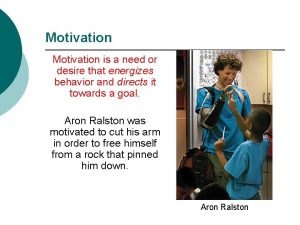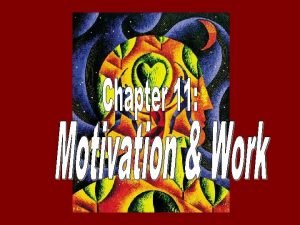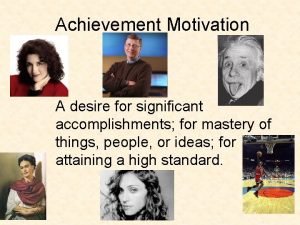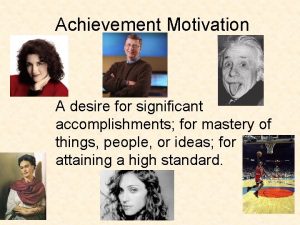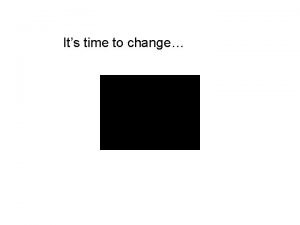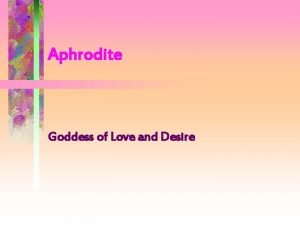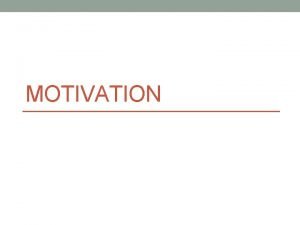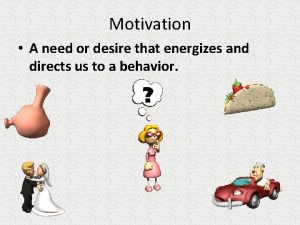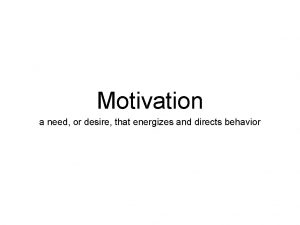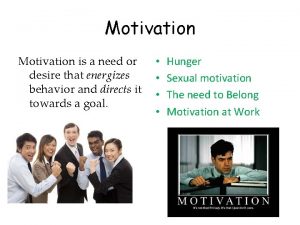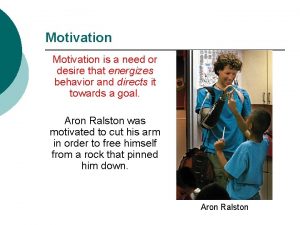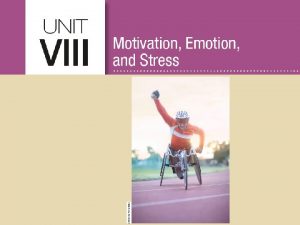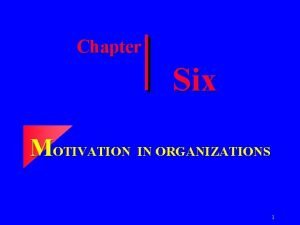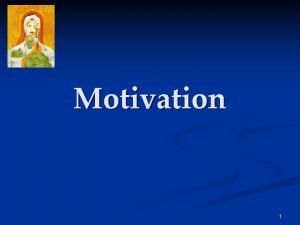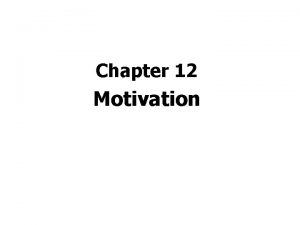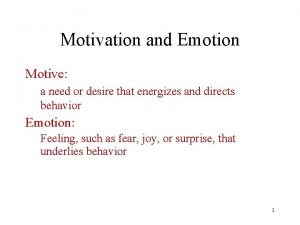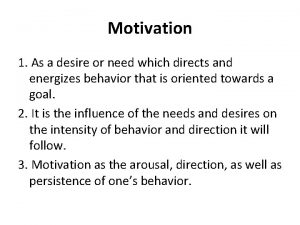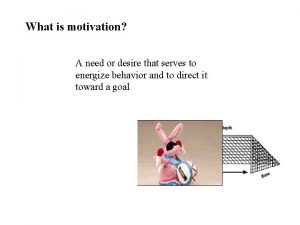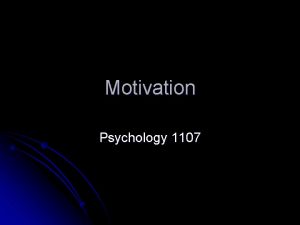Motivation a need or desire that energizes and



![Drive Reduction Push and Pull Theory § Homeostasis (push) [need] § Drive created by Drive Reduction Push and Pull Theory § Homeostasis (push) [need] § Drive created by](https://slidetodoc.com/presentation_image_h2/00813aebb2c0840ec6012a560405869f/image-4.jpg)















- Slides: 19

Motivation § a need or desire that energizes and directs behavior

Instinct Theory/Evolutionary Perspective • Instinct Theory/Evolutionary Perspective: we are motivated by our inborn automated behaviors. • Primarily applies to animals • Complex behaviors that have a fixed pattern throughout a species and are unlearned

Drive Reduction Theory • Our behavior is motivated by BIOLOGICAL NEEDS. • Wants to maintain homeostasis. • Shivering example • When we are not, we have a need that creates a drive. Need (e. g. , for food, water) Drive (hunger, thirst) PHYSIOLOGICAL PSYCHOLOGICAL Drive-reducing behaviors (eating, drinking)
![Drive Reduction Push and Pull Theory Homeostasis push need Drive created by Drive Reduction Push and Pull Theory § Homeostasis (push) [need] § Drive created by](https://slidetodoc.com/presentation_image_h2/00813aebb2c0840ec6012a560405869f/image-4.jpg)
Drive Reduction Push and Pull Theory § Homeostasis (push) [need] § Drive created by your body § regulation of any aspect of body chemistry around a particular level § Incentive (pull) [incentive] § environmental stimulus that motivates behavior § Need + incentive = strong drive § Hunger + freshly baked pie = dinner time

Arousal Theory • We are motivated to seek an optimum level of arousal. • Yerkes-Dodson Law: a moderate amount of stress or anxiety increases our performance

Maslow’s Hierarchy of Needs • Abraham Maslow said we are motivated by needs, and all needs are not created equal. • We are driven to satisfy the lower level needs first.

Motivation of HUNGER Multiple contributors to feeling of hunger: Stomach contractions Blood Sugar Glucose Hypothalamus Stomach hormones Basal Metabolic Rate

Stomach Contractions § Stomach contractions accompany our feelings of hunger § BUT… hunger remains if stomach is removed, therefore hunger does not come solely from the stomach

Brain Basis of Hunger • Stimulation to lateral (sides of) hypothalamus elicits hunger • Stimulation to ventromedial (lower-mid) hypothalamus depresses hunger • Rat on right has lesion on ventromedial hypothalamus; caused its weight to triple

Brain Basis of Hunger Lateral Hypothalamus • When stimulated it makes you hungry. • When lesioned (destroyed) you will never be hungry again. Ventromedial Hypothalamus • When stimulated you feel full. • When lesioned you will never feel full again.

Set Point Theory • The hypothalamus acts like a thermostat. • Wants to maintain a stable weight. • Activate the lateral when you diet and activate the ventromedial when you start to gain weight. • Metabolism: body’s base rate of energy expenditure

Culture and Hunger

Dog Mice Wine Fried Frog Legs Criadillas- bull testicles.

Obesity • Severely overweight to the point where it causes health issues. • Mostly eating habits but some people are predisposed towards obesity. • As you gain weight, you create MORE and BIGGER fat cells… as you lose the weight, the cells reduce is size BUT NEVER IN NUMBER. Click on the picture to see some case studies on obesity.


Eating Disorders Bulimia Nervosa • Characterized by binging (eating large amounts of food) and purging (getting rid of the food). • 1% of population

Anorexia Nervosa • Starve/exercise themselves to below 85% of their normal body weight. • See themselves as fat. • Vast majority are women. • 0. 6% of population Click on the woman to watch a case study of an anorexic.

Eating Disorders What causes eating disorders? – Genetics may influence susceptibility – Those with greatest body dissatisfaction – Western cultures idolize thin women » Cultural pressure transmitted by the “th ideal” exemplified in advertisements

Women’s Body Images
 What do we call a need or desire that energizes behavior
What do we call a need or desire that energizes behavior What do we call a need or desire that energizes behavior
What do we call a need or desire that energizes behavior Elizabeth energizes england
Elizabeth energizes england Is the individual internal process that energizes directs
Is the individual internal process that energizes directs Desire for significant accomplishment
Desire for significant accomplishment The desire for significant accomplishment for mastery
The desire for significant accomplishment for mastery Is the desire to make significant accomplishments
Is the desire to make significant accomplishments Ears in motivational interviewing
Ears in motivational interviewing Phân độ lown
Phân độ lown Block av độ 1
Block av độ 1 Thể thơ truyền thống
Thể thơ truyền thống Thơ thất ngôn tứ tuyệt đường luật
Thơ thất ngôn tứ tuyệt đường luật Walmart thất bại ở nhật
Walmart thất bại ở nhật Tìm vết của mặt phẳng
Tìm vết của mặt phẳng Con hãy đưa tay khi thấy người vấp ngã
Con hãy đưa tay khi thấy người vấp ngã Tôn thất thuyết là ai
Tôn thất thuyết là ai Gây tê cơ vuông thắt lưng
Gây tê cơ vuông thắt lưng Sau thất bại ở hồ điển triệt
Sau thất bại ở hồ điển triệt Goddess of love and desire
Goddess of love and desire Advantages of flow line maps
Advantages of flow line maps
